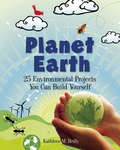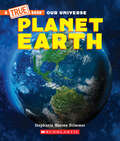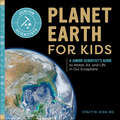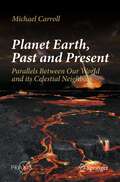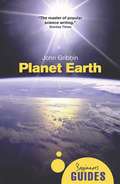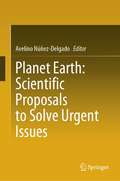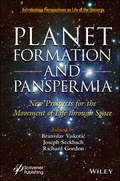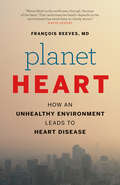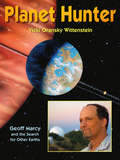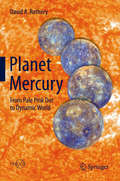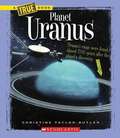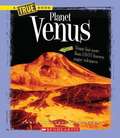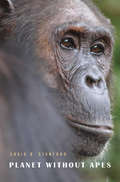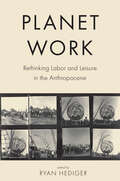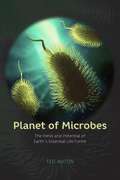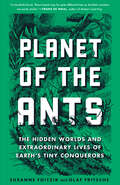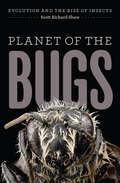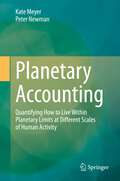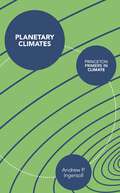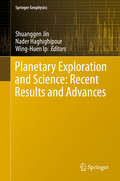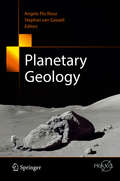- Table View
- List View
Planet Earth
by Farah Rizvi Kathleen M. ReillyPlanet Earth: 25 Environmental Projects You Can Build Yourself provides an engaging guide to the natural world and encourages children ages 9 and up to get their hands dirty and actively connect with the environment. It then introduces key environmental issues-wind and solar power, pollution, endangered species, global warming, and recycling-and posits potential solutions. Trivia, fun facts, and 25 captivating hands-on projects investigate ecology basics, such as the food chain, oxygen, and animal habitats, as well as ways to lessen the strain on Earth's resources by reducing human consumption and waste. With Planet Earth kids will learn how to respect and protect our unique planet.
Planet Earth (A True Book (Relaunch))
by Stephanie Warren DrimmerDiscover the wonder and learn the truth about our rocky home.Why does life exist on Earth but nowhere else in our solar system? What causes Earth's seasons? What makes up the Earth's interior? This book answers these questions and many more about our rocky home. From Earth's place in space, to its atmosphere and time zones, everything readers need to know about planet Earth is covered!Planets and stars, moons and galaxies! The universe is a vast and mysterious place with much to explore. And there's no better way to make amazing discoveries about space than with this reimagined series. With the latest NASA imagery, the classic structure and features of A True Book, and lively text, the titles in Our Universe bring the awe of the cosmos directly to readers. Students will come away with a wealth of knowledge about the incredible celestial bodies in our universe.This series covers Next Generation Science Standards core ideas including "The Universe and its stars" and "Earth and the solar system."
Planet Earth III: Accompanies the Landmark Series Narrated by David Attenborough
by Jonny Keeling Matt Brandon Michael GuntonThe official tie-in to the third instalment in the legendary Planet Earth franchiseFew places on Earth remain untouched by humans, creating challenges for the wildlife we share it with. We have entered a new age, and we must look at the splendour of the natural world through a different lens.From the depths of our oceans, to scorching deserts and the most remote jungles, Planet Earth III features spectacular places and surprising animal behaviours from all corners of our world. And for the first time, a human element is introduced to each landscape, highlighting how, in the age of the Anthropocene, today's planet has been forever changed by humanity and that wildlife now faces new challenges in our crowded, modern world.Featuring over 250 beautiful full-colour photographs, Planet Earth III reveals the wonders and trials of life on an increasingly fragile planet, bringing you closer than ever before to our world’s most intriguing species, unseen landscapes and natural phenomena.
Planet Earth for Kids: A Junior Scientist's Guide to Water, Air, and Life in Our Ecosphere (Junior Scientists)
by Stacy W KishExplore the land, water, and sky with the Junior Scientists series for kids ages 6 to 9 Have you ever wondered what makes the weather change? Or how mountains, rivers, and valleys get their shapes? Answer these questions and more with Planet Earth for Kids! You'll explore how our planet became the perfect home for all its plants and animals and how our air, sun, water, and dirt make planet Earth unique.Photos and illustrations—Beautiful pictures and fascinating diagrams let you take a peek at everything from penguins and storm clouds to the different types of rocks.Facts and activities—Discover what causes volcanoes, how much salt is really in the ocean, and even how to build your own solar-powered pizza oven!Earth ecosystems—Learn about the different biomes and habitats all over planet Earth and the plants and animals that work together to keep them healthy.Find out what keeps all life on Earth in balance with Planet Earth for Kids.
Planet Earth, Past and Present: Parallels Between Our World and its Celestial Neighbors (Springer Praxis Books)
by Michael CarrollThe Earth is not the world it once was, and it is not the world it will always be. This book describes the exciting, complex, and occasionally baffling history of our own planet. Over the course of its 4.5 billion years, Earth has undergone astonishing changes to its surface and atmosphere, at times more closely resembling other planets in our Solar System than the habitable, teeming biosphere of today. Through these otherworldly analogs, author-illustrator Michael Carroll teaches readers about different aspects of our own planet’s past. Our nearest cosmic neighbor, Venus, offers insights into Earth’s own young atmosphere and surface, while Saturn’s moon Titan may offer a window into the genesis of life on Earth. Planet Earth, Past and Present explores these and many more connections. Original art accompanies each chapter, depicting major stages of the Earth’s evolution and providing vivid comparisons to other planets or moons. Come along on this journey through the Solar System—a journey that ultimately leads us home.
Planet Earth: A Beginner's Guide (Beginner's Guides)
by John GribbinIn this incredible expedition into the origins, workings, and evolution of our home planet, John Gribbin, bestselling author of In Search of Schrödinger's Cat, The Scientists, and In Search of the Multiverse, does what he does best: taking four and a half billion years of mind-boggling science and digging out the best bits. From the physics of Newton and the geology of Wegener, to the environmentalism of Lovelock, this is a must read for Earth's scientists and residents alike. Trained as an astrophysicist at Cambridge University, John Gribbin is currently Visiting Fellow in Astronomy at the University of Sussex, England.
Planet Earth: Scientific Proposals to Solve Urgent Issues
by Avelino Núñez-DelgadoThis book represents the most comprehensive overview of issues affecting our planet and the forefront solutions, including climate change, air, water, soil pollution, demography, and access to food and water. This edited book, led by Prof. Núñez-Delgado, counts with the participation of leading researchers across a wide range of disciplines to be an inspiring and motivating document to promote sustainability and biodiversity. Those of you asking for trustworthy analyses about sustainability and climate change and the vanguard solutions will find this book fascinating.
Planet Formation and Panspermia: New Prospects for the Movement of Life Through Space (Astrobiology Perspectives on Life in the Universe)
by Richard Gordon Joseph Seckbach Branislav VukotićAn in-depth view of the panspermia hypothesis examined against the latest knowledge of planetary formation and related processes. Panspermia is the concept that life can be passively transported through space on various bodies and seed, habitable planets and moons, which we are beginning to learn may exist in large numbers. It is an old idea, but not popular with those who prefer that life on Earth started on Earth, an alternative, also unproven hypothesis. This book updates the concept of panspermia in the light of new evidence on planet formation, molecular clouds, solar system motions, supernovae ejection mechanisms, etc. Thus, it is to be a book about newly understood prospects for the movement of life through space. The novel approach presented in this book gives new insights into the panspermia theory and its connection with planetary formation and the evolution of galaxies. This offers a good starting point for future research proposals about exolife and a better perspective for empirical scrutiny of panspermia theory. Also, the key to understanding life in the universe is to understand that the planetary formation process is convolved with the evolution of stellar systems in their galactic environment. The book provides the synthesis of all these elements and gives the readers an up-to-date insight on how panspermia might fit into the big picture. Audience Given the intrinsic interdisciplinary nature of the panspermia hypothesis the book will have a wide audience across various scientific disciplines covering astronomy, biology, physics and chemistry. Apart from scientists, the book will appeal to engineers who are involved in planning and realization of future space missions.
Planet Heart
by François ReevesWe've all heard the risk factors for cardiovascular disease: high blood pressure, high cholesterol, obesity, smoking, stress, and a sedentary lifestyle. But what about our environment? Despite almost 500 recent studies that show the links between air and water quality, biodiversity, and heart health, a poor environment as a critical cardiovascular risk factor has largely been ignored. In Planet Heart, cardiologist François Reeves aims to redress this imbalance with an incisive and authoritative look at the subject. Why did North America experience an explosion of cardiovascular disease in the mid-20th century? Why are people in China, who were until recently protected from cardiovascular disease, now suffering a surge of heart attacks? Why are there more heart attacks during episodes of smog? Why would living near an urban green space halve the difference in cardiac mortality between the rich and poor? In his lively, accessible text, Reeves not only sheds light on these questions with the latest scientific evidence but also offers tangible solutions that could mean better health for our hearts and for our planet.Published in partnership with the David Suzuki Foundation
Planet Hunter: Geoff Marcy and the Search for Other Earths
by Vicki O. WittensteinHe has discovered more planets than anyone in history. In this inspiring true story, winner of the American Institute of Physics Award, Geoff Marcy's love of space helped him overcome struggles in his studies until finally he became an astronomer. <P><P> But he was not on track to make major discoveries. Eventually, he went back to the questions that thrilled him as a boy: Are we alone? Do Earth-like planets orbit the stars in the night sky? It would not be easy to find a planet outside our solar system. Others had tried and failed. But Marcy never gave up. Since 1995, he and his colleagues have discovered nearly half of the 380 known "extrasolar" planets. Stunning paintings transport the reader to the exotic worlds that he and others have found.
Planet Joy
by Jenny ValentineFor readers aged 9+ comes the third book in a sparkling series about family, friends and finding the joy in life! From Guardian award-winning author Jenny Valentine, this is the perfect series for fans of Jacqueline Wilson, Cath Howe and Lara Williamson! Meet ten-year-old Joy Applebloom, a girl with a knack for finding the silver lining in even the darkest of rainclouds. After years of travelling the world with her family, Joy feels like she&’s finally found a place she can call home. She&’s settled in at school, has a new best friend called Benny and she&’s finally making a difference in the world. But when a new girl, Phoebe Dark, joins class 6C, Joy discovers there&’s a whole world out there that she hasn&’t explored yet . . . Could Plane Tree Gardens be just the beginning?A heart-warming and joyful series about family, friends and never being too small to make a difference, with gorgeous illustrations from Claire Lefevre. 'A delight for its warmth and humour, but principally because the writing is alive and stunning' The Sunday Times on A Girl Called Joy
Planet Mercury
by David A. RotheryA new and detailed picture of Mercury is emerging thanks to NASA's MESSENGER mission that spent four years in orbit about the Sun's innermost planet. Comprehensively illustrated by close-up images and other data, the author describes Mercury's landscapes from a geological perspective: from sublimation hollows, to volcanic vents, to lava plains, to giant thrust faults. He considers what its giant core, internal structure and weird composition have to tell us about the formation and evolution of a planet so close to the Sun. This is of special significance in view of the discovery of so many exoplanets in similarly close orbits about their stars. Mercury generates its own magnetic field, like the Earth (but unlike Venus, Mars and the Moon), and the interplay between Mercury's and the Sun's magnetic field affects many processes on its surface and in the rich and diverse exosphere of neutral and charged particles surrounding the planet. There is much about Mercury that we still don't understand. Accessible to the amateur, but also a handy state-of-the-art digest for students and researchers, the book shows how our knowledge of Mercury developed over the past century of ground-based, fly-by and orbital observations, and looks ahead at the mysteries remaining for future missions to explore.
Planet Name Game (Step into Reading)
by Tom Brannon Tish RabeA Step 2 Step into Reading Science Reader based on an episode of the hit PBS Kids TV show The Cat in the Hat Knows a Lot About That! Join the Cat in the Hat as he takes Sally and Nick on an adventure into space to learn the names of the eight planets in our solar system! Written in rhyme for children who can read with help, this Step 2 book is a great way to introduce beginning readers to basic concepts about space and to support the Common Core State Standards. Step 2 Readers use basic vocabulary and short sentences to tell simple stories. For children who recognize familiar words and can sound out new words with help.
Planet Uranus (A True Book)
by Christine Taylor-ButlerSpace series dives into the many components that make each planet distinctive and exceptional, as well as explore many of the other components that make up Space.
Planet Venus (New True Books: Space)
by Christine Taylor-ButlerUnlike most other planets, Venus can be seen from Earth's surface with the naked eye. Only the moon burns brighter in the night sky. A True Book: Space series dives into the many components that make each planet distinctive and exceptional, as well as explore many of the other components that make up Space. This series includes an age appropriate (grades 3-5) introduction to curriculum-relevant subjects and a robust resource section that encourages independent study. Lexile Measure: 810L
Planet Without Apes
by Craig B. StanfordPlanet Without Apes demands that we consider whether we can live with the consequences of wiping our closest relatives off the face of the Earth. Leading primatologist Craig Stanford warns that extinction of the great apes—chimpanzees, bonobos, gorillas, and orangutans—threatens to become a reality within just a few human generations. We are on the verge of losing the last links to our evolutionary past, and to all the biological knowledge about ourselves that would die along with them. The crisis we face is tantamount to standing aside while our last extended family members vanish from the planet. Stanford sees great apes as not only intelligent but also possessed of a culture: both toolmakers and social beings capable of passing cultural knowledge down through generations. Compelled by his field research to take up the cause of conservation, he is unequivocal about where responsibility for extinction of these species lies. Our extermination campaign against the great apes has been as brutal as the genocide we have long practiced on one another. Stanford shows how complicity is shared by people far removed from apes’ shrinking habitats. We learn about extinction’s complex links with cell phones, European meat eaters, and ecotourism, along with the effects of Ebola virus, poverty, and political instability. Even the most environmentally concerned observers are unaware of many specific threats faced by great apes. Stanford fills us in, and then tells us how we can redirect the course of an otherwise bleak future.
Planet Work: Rethinking Labor and Leisure in the Anthropocene
by James Armstrong Jennifer K. Ladino Amanda Adams Ted Geier Sharon O'Dair Ryan Hediger David Rodland Sinan Akilli Daniel Clausen Matt Wanat Will Elliot Kevin Maier Jo ReyLabor and labor norms orient much of contemporary life, organizing our days and years and driving planetary environmental change. Yet, labor, as a foundational set of values and practices, has not been sufficiently interrogated in the context of the environmental humanities for its profound role in climate change and other crises. This collection of essays demonstrates the urgent need to rethink models and customs of labor and leisure in the Anthropocene. Recognizing the grave traumas and hazards plaguing planet Earth, contributors expose fundamental flaws in ideas of work and search for ways to redirect cultures toward more sustainable modes of life. These essays evaluate Anthropocene frames of interpretation, dramatize problems and potentials in regimes of labor, and explore leisure practices such as walking and storytelling as modes of recasting life, while a coda advocates reviving notions of work as craft.
Planet of Microbes: The Perils and Potential of Earth's Essential Life Forms
by Ted AntonWe live in a time of unprecedented scientific knowledge about the origins of life on Earth. But if we want to grasp the big picture, we have to start small—very small. That’s because the real heroes of the story of life on Earth are microbes, the tiny living organisms we cannot see with the naked eye. Microbes were Earth’s first lifeforms, early anaerobic inhabitants that created the air we breathe. Today they live, invisible and seemingly invincible, in every corner of the planet, from Yellowstone’s scalding hot springs to Antarctic mountaintops to inside our very bodies—more than a hundred trillion of them. Don’t be alarmed though: many microbes are allies in achieving our—to say nothing of our planet’s—health. In Planet of Microbes, Ted Anton takes readers through the most recent discoveries about microbes, revealing their unexpected potential to reshape the future of the planet. For years, we knew little about these invisible invaders, considering them as little more than our enemies in our fight against infectious disease. But the more we learn about microbes, the more it’s become clear that our very lives depend on them. They may also hold the answers to some of science’s most pressing problems, including how to combat a warming planet, clean up the environment, and help the body fight off a wide variety of diseases. Anton has spent years interviewing and working with the determined scientists who hope to harness the work of microbes, and he breaks down the science while also sharing incredible behind-the-scenes stories of the research taking place everywhere from microbreweries to Mars. The world’s tiniest organisms were here more than three billion years before us. We live in their world, and Planet of Microbes at last gives these unsung heroes the recognition they deserve.
Planet of the Ants: The Hidden Worlds And Extraordinary Lives Of Earth's Tiny Conquerors
by Olaf Fritsche Susanne Foitzik“Beautifully illustrated with color photographs, the book offers a view into parallels between seemingly out-of-this-world ant societies and our own, including cities, an intense work ethic, division of labor, intragroup cooperation combined with genocidal outgroup warfare, even a kind of to-the-death national loyalty. The authors’ scientific rigor is matched by their joy in their subjects.”—The Wall Street Journal Shortlisted for the 2022 Helen and Kurt Wolff Translator’s Prize This sweeping portrait of the world’s uncontested six-legged conquerors will open your eyes to the secret societies thriving right beneath your feet—and shift your perspective on humanity. The closer you get to ants, the more human they look. Ants build megacities, tend gardens, wage wars, and farm livestock. Ants have flourished since the age of the dinosaurs. There are one million ants for every one of us. Engineered by nature to fulfill their particular roles, ants flawlessly perform a complex symphony of tasks to sustain their colony—seemingly without a conductor—from fearsome army ants, who stage twelve-hour hunting raids where they devour thousands, to gentle leafcutters cooperatively gardening in their peaceful underground kingdoms. Acclaimed biologist Susanne Foitzik has traveled the globe to study these master architects of Earth. Joined by journalist Olaf Fritsche, Foitzik invites readers deep into her world in both the field and the lab. Exploring these insects’ tiny yet incredible lives will inspire new respect for ants as a global superpower. Publisher’s note: Planet of the Ants was previously published in hardcover as Empire of Ants.
Planet of the Bugs: Evolution and the Rise of Insects
by Scott Richard ShawDinosaurs, however toothy, did not rule the earth--and neither do humans. But what were and are the true potentates of our planet? Insects, says Scott Richard Shaw--"millions" and "millions" of insects. Starting in the shallow oceans of ancient Earth and ending in the far reaches of outer space--where, Shaw proposes, insect-like aliens may have achieved similar preeminence--"Planet of the Bugs" spins a sweeping account of insects' evolution from humble arthropod ancestors into the bugs we know and love (or fear and hate) today. Leaving no stone unturned, Shaw explores how evolutionary innovations such as small body size, wings, metamorphosis, and parasitic behavior have enabled insects to disperse widely, occupy increasingly narrow niches, and survive global catastrophes in their rise to dominance. Through buggy tales by turns bizarre and comical--from caddisflies that construct portable houses or weave silken aquatic nets to trap floating debris, to parasitic wasp larvae that develop in the blood of host insects and, by storing waste products in their rear ends, are able to postpone defecation until after they emerge--he not only unearths how changes in our planet's geology, flora, and fauna contributed to insects' success, but also how, in return, insects came to shape terrestrial ecosystems and amplify biodiversity. Indeed, in his visits to modern earth's hyperdiverse rain forests to highlight the current insect extinction crisis, Shaw reaffirms just how critical these tiny beings are to planetary health and human survival. In this age of honeybee die-offs and bedbugs hitching rides in the spines of library books, "Planet of the Bugs "charms with humor, affection, and insight into the world's six-legged creatures, revealing an essential importance that resonates across time and space.
Planet-Friendly Hacks: Simple Tips and Budget-Friendly Advice for Sustainable Living
by Elizabeth AjaoThis handy guide is brimming with quick tips, life hacks and budget-friendly tricks to help you reduce your carbon footprint and live more sustainablyAn eco-friendly lifestyle is expensive and time-consuming, right? Wrong! There are countless ways to make green choices that don’t take a toll on your time, your bank balance or the planet.This book is your one-stop guide to living a more sustainable lifestyle. Whether you need tips on conserving energy or reducing food waste, or you want to give your home a makeover without impacting the planet, these pages include everything you need to get started. You will find:Clever life hacks to make reducing your carbon footprint that bit easierSimple tips to help you make planet-friendly choices in everyday lifeSmart advice for eco-living on a budgetInspiration for eco-friendly crafts and DIY projectsIt’s more important than ever to do our bit for the environment, and Planet-Friendly Hacks will help you live life to the full without costing the earth.
Planetary Accounting: Quantifying How to Live Within Planetary Limits at Different Scales of Human Activity
by Peter Newman Kate MeyerThis book presents a novel way to enable people, regardless of their scale of influence, to take responsibility for global environmental problems including climate change. It introduces a new framework called Planetary Accounting, which allows the Planetary Boundaries, non-negotiable limits for the environment, to be translated into limits for human activity. It shows how such limits can be broken down into chunks that can be managed at different levels (from individual and community, to business and sector levels, to cities and regions), and at any level of government. The book begins by summarising the science of climate change and introducing the notion of the Anthropocene – the “human age”. It highlights the importance of returning to and remaining within the Planetary Boundaries but shows that we can’t realistically do so unless we have a new approach to environmental accounting.The book then outlines how Planetary Accounting furnishes this new approach by combining sustainability science, change theory, and environmental accounting to create a scalable framework for environmental management that encourages systemic and individual change. The details of the science of and our human contribution to ten critical human pressures are then presented, and the book concludes with a guide for those seeking to apply Planetary Accounting in practice. Planetary Accounting could form the scientific underpinning of behaviour change programs, guide the development of policy and regulations, and provide both the basis for environmental laws, and the foundation of future global environmental agreements. It has been 50 years since the first views from space showed a blue planet alone in our solar system. This book is an historic opportunity to provide humanity for the first time with sufficient information to begin implementing Planetary Accounting.
Planetary Climates (Princeton Primers in Climate #9)
by Andrew IngersollThis concise, sophisticated introduction to planetary climates explains the global physical and chemical processes that determine climate on any planet or major planetary satellite--from Mercury to Neptune and even large moons such as Saturn's Titan. Although the climates of other worlds are extremely diverse, the chemical and physical processes that shape their dynamics are the same. As this book makes clear, the better we can understand how various planetary climates formed and evolved, the better we can understand Earth's climate history and future.
Planetary Exploration and Science: Recent Results and Advances
by Shuanggen Jin Nader Haghighipour Wing-Huen IpThis contributed monograph is the first work to present the latest results and findings on the new topic and hot field of planetary exploration and sciences, e. g. , lunar surface iron content and mare orientale basalts, Earth's gravity field, Martian radar exploration, crater recognition, ionosphere and astrobiology, Comet ionosphere, exoplanetary atmospheres and planet formation in binaries. By providing detailed theory and examples, this book helps readers to quickly familiarize themselves with the field. In addition, it offers a special section on next-generation planetary exploration, which opens a new landscape for future exploration plans and missions. Prof. Shuanggen Jin works at the Shanghai Astronomical Observatory, Chinese Academy of Sciences, China. Dr. Nader Haghighipour works at the University of Hawaii-Manoa, USA. Prof. Wing-Huen Ip works at the National Central University, Taiwan.
Planetary Geology
by Angelo Pio Rossi Stephan Van GasseltThis book provides an up-to-date interdisciplinary geoscience-focused overview of solid solar system bodies and their evolution, based on the comparative description of processes acting on them. Planetary research today is a strongly multidisciplinary endeavor with efforts coming from engineering and natural sciences. Key focal areas of study are the solid surfaces found in our Solar System. Some have a direct interaction with the interplanetary medium and others have dynamic atmospheres. In any of those cases, the geological records of those surfaces (and sub-surfaces) are key to understanding the Solar System as a whole: its evolution and the planetary perspective of our own planet. This book has a modular structure and is divided into 4 sections comprising 15 chapters in total. Each section builds upon the previous one but is also self-standing. The sections are: Methods and tools Processes and Sources Integration and Geological Syntheses Frontiers The latter covers the far-reaching broad topics of exobiology, early life, extreme environments and planetary resources, all areas where major advancements are expected in the forthcoming decades and both key to human exploration of the Solar System. The target readership includes advanced undergraduate students in geoscience-related topics with no specific planetary science knowledge; undergraduates in other natural science domains (e. g. physics, astronomy, biology or chemistry); graduates in engineering and space systems design who want to complement their knowledge in planetary science. The authors' backgrounds span a broad range of topics and disciplines: rooted in Earth geoscience, their expertise covers remote sensing and cartography, field mapping, impact cratering, volcanology and tectonics, sedimentology and stratigraphy exobiology and life in extreme environments, planetary resources and mining. Several generations of planetary scientists are cooperating to provide a modern view on a discipline developed from Earth during and through Space exploration.
